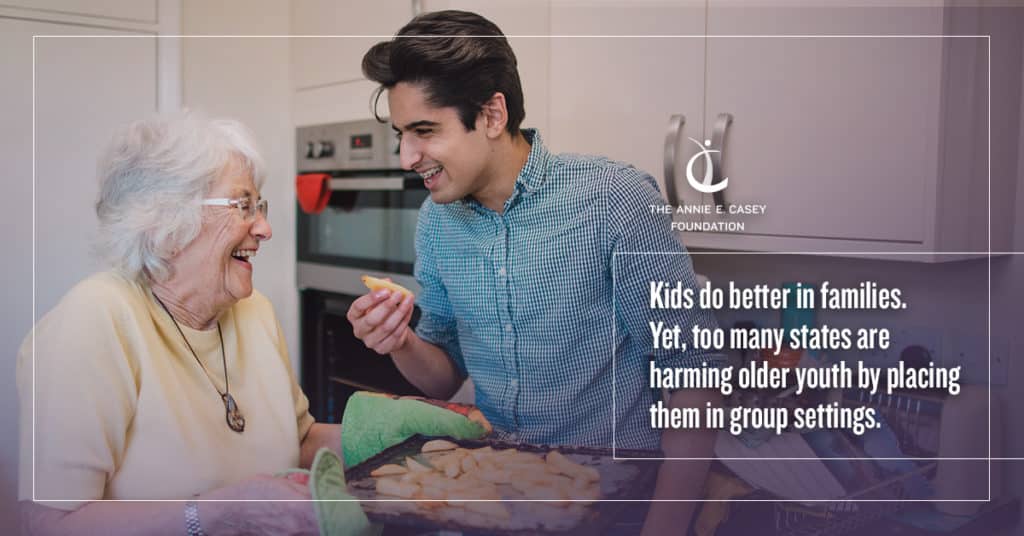Children in Foster Care Increasingly Likely to Live in Families, the Annie E. Casey Foundation Finds
Print This Post
New Federal Law Poised to Help States Keep More Kids Connected to Families, But New KIDS COUNTâ State-by-State Data Show Stagnation for Teens and Persistent Racial Disparities
The Annie E. Casey Foundation today released Keeping Kids in Families: Trends in Placement of Young People in Foster Care in the United States,using data from the child welfare system across all 50 states and the District of Columbia over a 10-year period to look at how placements for young people in foster care have changed. The report finds that nationwide care systems placed 86 percent of these children in families in 2017, compared with 81 percent in 2007. But despite this improvement, the data reveal the group placement rate for teens has remained stagnant, and there are persistent racial disparities for children of all ages in foster care.
Being part of a family is a basic human need and essential to well-being, especially for children, teenagers and young adults who are rapidly developing and transitioning to independence, as documented in the Casey Foundation’s 2015 report, Every Kid Needs a Family. The new data suggest a growing consensus among practitioners and policymakers that young people in the child welfare system should live in families. Through the Family First Prevention Services Act, signed into law in 2018, states are empowered to prioritize family placement and high-quality, family-centered settings which produce the best outcomes for young people.
“Child welfare systems are making progress in keeping children with families, which we know leads to better outcomes for young people,” said Lisa Hamilton, the Casey Foundation’s president and CEO. “But systems must do more to find families for teenagers and youth of color. We see success in several states, and other jurisdictions could apply these lessons.”
Here are some key findings from Keeping Kids in Families:
- For teenagers, progress in family placements has been elusive. Nationwide, more than a third of young people in child welfare systems who are 13 and older lived in group placements in 2017 ― the same proportion as 10 years ago.
- A breakdown by race shows that progress is highly uneven. Systems increased the placement rate of white youth in family homes from 81 percent to 87 percent, but outcomes for Latino and African-American children improved by just 3 percent, and by just 1 percentage point for Asian-American children.
- Placement in foster families to whom children were not related dipped slightly, from 46 percent to 45 percent.
Placing young people with relatives or close friends when they cannot live with their birth families helps minimize the trauma of removal, maintaining vital connections and often keeping sibling groups together. Children in kin placements are generally less likely to run away, and relatives are less likely to request that children be removed when their behavior becomes difficult.
“The Family First Act can provide state leaders with policy support and federal resources to keep the focus on family placement for the benefit of young people,” said Tracey Feild, director and manager of the Casey Foundation’s Child Welfare Strategy Group. “Since some states have shown improvements keeping young people in families, we know that it can be done and that all states can improve.”
The Casey Foundation calls on state child welfare systems to use the opportunities afforded by Family First to increase available services to stabilize families. Similarly, states can:
- prioritize recruitment of kin and foster families for older youth and youth of color in recruitment planning;
- engage families in decision making, since kin and foster parents should be treated as important members of a child’s team; and
- require director approval for non-kin placements.
Keeping Kids in Families shows real progress in some states. Sixteen states and the District of Columbia placed 90 percent or more of young people in families in 2017, showing that others can do the same. The Annie E. Casey Foundation encourages advocates, policymakers, and child welfare leaders to use this information to create better outcomes for youth who have experienced the foster care system.
Contact:
Rebecca Rice
Georgia KIDS COUNT Manager
Georgia Family Connection Partnership
404-507-0488
rebecca@gafcp.org
Bill Valladares
GaFCP Communications Director
404-739-0043
william@gafcp.org
Follow us on Twitter: @gafcpnews
Connect with us on Facebook
Georgia Family Connection Partnership (GaFCP) is a
public-private partnership created by the State of Georgia and investors
from the private sector to assist communities in addressing the serious
challenges facing children and families. GaFCP also serves as a
resource to state agencies across Georgia that work to improve the
conditions of children and families. Georgia KIDS COUNT provides
policymakers and citizens with current data they need to make informed
decisions regarding priorities, services, and resources that impact
Georgia’s children, youth, families, and communities. Georgia KIDS COUNT
is funded, in part, through a grant from The Annie E. Casey Foundation,
a private charitable organization dedicated to helping build better
futures for disadvantaged children in the United States. For more
information, visit gafcp.org.
The Annie E. Casey Foundation creates a brighter future for the nation’s children by developing solutions to strengthen families, build paths to economic opportunity and transform struggling communities into safer and healthier places to live, work and grow. For more information, visit aecf.org. KIDS COUNT® is a registered trademark of the Annie E. Casey Foundation.
